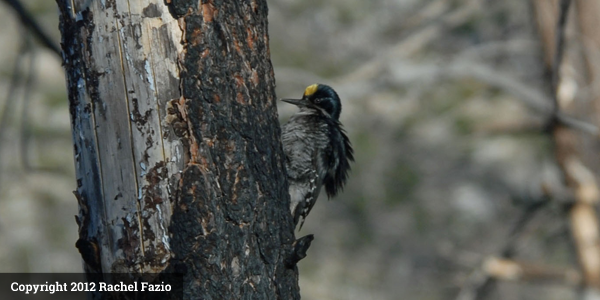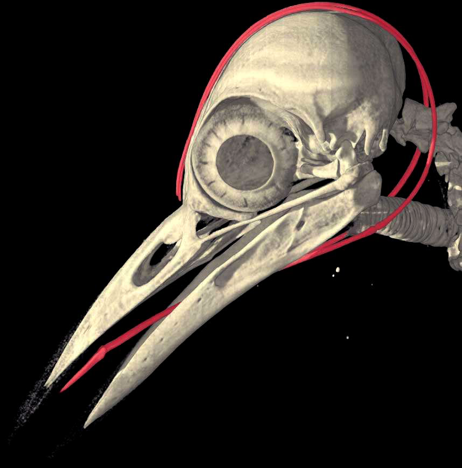Posts by Rachel Fazio
Black-Backed Woodpeckers
 Black-Backed Woodpeckers
Black-Backed Woodpeckers
Need It To Survive
Blacked Backed Woodpeckers like their mature and old growth forest well done. Each bird eats over 13,500 wood boring beetle larvae per year to survive – this means lots of dead trees (over 100 per acre) covering a large area (approximately 300 acres per pair).
[cmsms_button button_link=”https://johnmuirproject.org/legal-pursuits/fesa-protection-sought-for-the-black-backed-woodpecker/” button_target=”self” button_text_align=”left” button_font_weight=”100″ button_font_style=”normal” button_padding_hor=”20″ button_text_color_h=”#ffffff” animation_delay=”0″]LEARN MORE[/cmsms_button]
Read MoreCalifornia Spotted Owls
 California Spotted Owls
California Spotted Owls
Choose It For Foraging
Spotted owls prefer unburned mature forest or mature forest that burns at lower intensity for nesting and roosting, but use mature forest that burns at high intensity to hunt the small mammals that they need to eat to survive. Without this habitat in their territories, populations decline.
[cmsms_button button_link=”https://johnmuirproject.org/legal-pursuits/fesa-protection-sought-for-california-spotted-owl/” button_target=”self” button_text_align=”left” button_font_weight=”100″ button_font_style=”normal” button_padding_hor=”20″ button_text_color_h=”#ffffff” animation_delay=”0″]LEARN MORE[/cmsms_button]
Read MorePacific Fisher
 The Pacific Fisher
The Pacific Fisher
A Very Rare Carnivore
Once thought to avoid higher intensity fire areas, it has been found to select dense old forest in both its unburned state (for denning and resting) and after it is burned in a higher intensity fire (for hunting small mammals).
[cmsms_button button_link=”https://johnmuirproject.org/scientific-research/fishers-use-of-fire-areas-kern-plateau-sequoia-national-forest/” button_target=”self” button_text_align=”left” button_font_weight=”100″ button_font_style=”normal” button_padding_hor=”20″ button_text_color_h=”#ffffff” animation_delay=”0″]LEARN MORE[/cmsms_button]
Read MoreThe Black-Backed Woodpecker (Picoides arcticus)
This very rare bird depends upon large patches of habitat created when high-intensity fire burns in dense, old conifer forest. This habitat is only suitable for Black-Backeds for about 7-8 years after a fire burns, at which time they must find a newly created high-intensity fire area within 30 miles or so of their current home. The larger the high-intensity fire patch and the larger the trees the longer an area remains suitable. Post-fire logging projects eliminate their habitat and their presence in these areas.
[gallery columns="2" link="none" ids="199,428"]
Black-Backed Woodpeckers are specifically designed to fit into the burned landscape. They are highly camouflaged, with their jet black backs protecting them from predators. They have only three toes, instead of four (one of only two bird species in North America with this feature) which gives them added heel mobility and enhanced strike force, making it possible for them to forage and excavate nest cavities in recently killed trees (otherwise known as hard snags). In fact they mate for life, and excavate one or more new nest cavities every year. They are quite simply the homebuilders of the burned forest as their unused or old nest cavities provide nests for other animals such as mountain bluebirds, nuthatches and flying squirrels, to name a few. Because this woodpecker strikes dead trees (snags) which have not yet decayed with such force they evolved with fluid sacks in their skull which fill up before each strike (similar to an air bag in your car), protecting their brain from impact.
[audio mp3="https://johnmuirproject.org/wp-content/uploads/2014/10/1001_1.mp3"][/audio]
Unfortunately there exist no protections for this unique and important animal or its habitat, which is why the John Muir Project and the Center for Biological Diversity have petitioned to have it protected under both the California and Federal Endangered Species Acts.
Did You Know
that California Spotted Owls have returned to the Stanislaus National Forest in the area where the 2013 Rim Fire burned?
In fact, not only have the Spotted Owls returned (there are 70 owls occupying 39 territories) but they are occupying the area in numbers greater than are normally found in unburned mature and old forest.
This is because unburned habitat, which is suitable for spotted owl nesting and roosting, becomes some of the best and most preferred foraging / hunting habitat for the owls when it burns at high intensity (just ask the owls themselves as they seek it out above all other habitats when it is available).
This is because high-intensity fire creates perfect conditions for the Spotted Owl’s small mammal prey species to thrive and multiply. An easy meal means greater chances of survival for the owls and a better chance that they will successfully reproduce and that their babies will also survive!
Read MoreDid You Know
that patches of high-intensity fire—where most or all trees are killed—create “complex early seral forest” (CESF)?
CESF is the most biodiverse, rarest, and most threatened forest habitat type in the western United States (even more so than unburned old forest).
Read MoreWildlife Groups Sue Feds Over California Logging
By Scott Smith, Associated Press
The San Diego Union-Tribune
Environmentalists filed a lawsuit Thursday against a federal agency, saying it aims to protect the California spotted owl living in the burned forests marked for logging after the third-largest wildfire in state history.
Read MoreUS Forest Service Moves to Start Clearcutting in Rim Fire Area
August 28, 2014
By Chad Hanson, Ph.D.
Earth Island Journal
Massive logging proposal threatens many spotted owls, currently thriving in the fire-affected acres of Stanislaus National Forest.
Read MoreCalifornia Spotted Owls Using Burned Sierra Forest Slated for Logging
By Chris Clarke
PBS SoCal
33 breeding pairs of the declining spotted owls have taken up residence in burned forest in the Rim Fire area, will these homeranges be destroyed by logging or protected?
Read MoreThe Yosemite Rim Fire Revisited
June 3, 2014
By Chad Hanson, Ph.D.
Earth Island Journal
The forest is coming back to life; Forest Service plan to log there is a bad idea.
Read More
